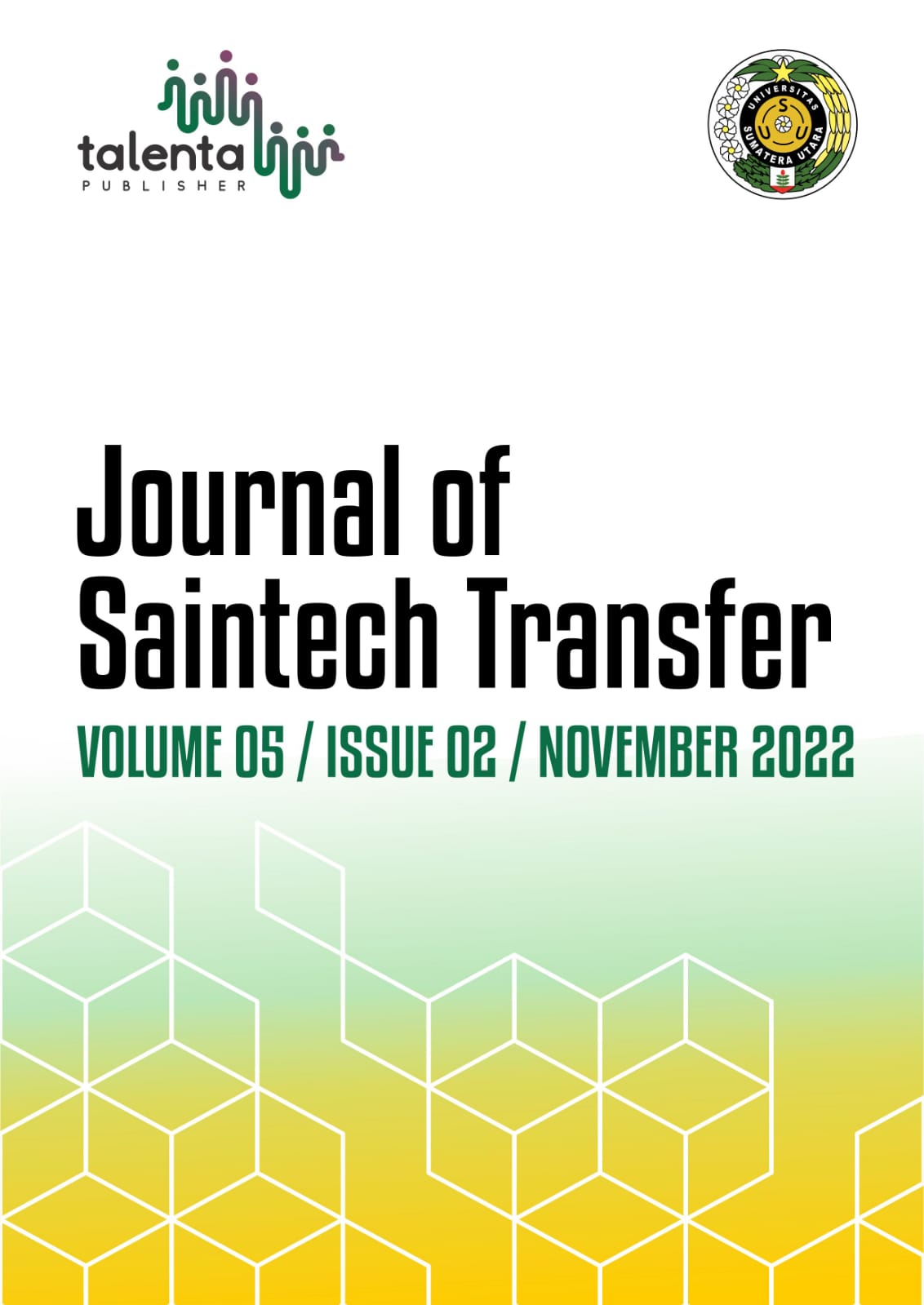- Cultivation of Acem acem (Oxalis dehradunesis Raizada) and Its Utilization as a Hand Sanitizer for Protection of Exposure to Chemical Pesticides
-
DOI:
https://doi.org/10.32734/jst.v5i2.9842Abstract
Farmers in Tanah Karo still use chemical pesticides a lot and often experience direct exposure to pesticides due to not using personal protection during pesticide spraying. Based on the farmers' habits, exposure to pesticides is cleaned by rubbing the leaves of acem acem (Oxalis dehradunensis Raizada) to the dirty and exposed parts of the pesticide. Acem acem leaves have many benefits and are local potentials that can be new opportunities for farmers to process acem acem leaves into products that have economic value. In addition, acem acem leaves that grow wild and are scattered in every farmer's field in Tanah Karo become an obstacle in providing raw materials in large quantities because it will take a lot of time, effort, and money to collect them. The purpose of this community partnership program is to develop acem acem leaves as raw material for hand sanitizers by means of intensive cultivation, increase farmers' understanding of the use of acem acem leaves in protecting exposure to chemical pesticides, empower farming communities in making hand sanitizers made from acem acem leaves. The solution to partner problems is to cultivate acem acem as raw materials, educate the farming community to utilize acem acem leaves into products that have economic value such as hand sanitizers so that they can increase farmers' income. The implementation of community partnership service activities is carried out by training at each stage of acem acem cultivation, maintenance of acem acem, harvesting, and post-harvest as well as processing acem acem into hand sanitizers, as well as direct practice of demonstration plots for acem acem cultivation.
Downloads
References
Mahyuni EL. “Faktor Risiko dalam Penggunaan Pestisida Terhadap Keluhan Kesehatan pada Petani di Kecamatan Berastagi Kabupaten Karo 2014, [Risk Factors in the Use of Pesticides Against Health Complaints in Farmers in Berastagi District, Karo District 2014]â€. Kesehat Masy. Vol. 9, No. 1, pp. 79–89. 2015.
Mahyuni EL, Sinaga MM. Keracunan Pestisida Berdasarkan Gejala Fisik dan Aktivitas Enzym Cholinesterase pada Petani di Desa Sumber Mufakat Kabanjahe. In: Prosiding Kongres Nasional Ikatan Ahli Kesehatan Masyarakat ke-13 (KONAS IAKMI XIII) “Masyarakat Hidup Sehat dan Bahagia dalam Mencapai Sasaran Pembangunan Berkelanjutan ( SDGs 2030 ), [Pesticide Poisoning Based on Physical Symptoms and Cholinesterase Enzyme Activity in Farmers in Sumber Mufakat Village, Kabanjahe. In: Proceedings of the 13th National Congress of the Association of Public Health Experts (KONAS IAKMI XIII) "People Live Healthy and Happy in Achieving Sustainable Development Goals (SDGs 2030)†Edisi Kedua. p. 643–6. 2016.
Prijanto TB, Nurjazuli N, Sulistiyani S. “Analisis Faktor Risiko Keracunan Pestisida Organofosfat Pada Keluarga Petani Hortikultura di Kecamatan Ngablak Kabupaten Magelang. [Risk Factor Analysis of Organophosphate Pesticide Poisoning in Horticultural Farmer Families in Ngablak District, Magelang Regency]â€. J Kesehat Lingkung Indones. Vol. 8, No. 2, pp. 73–8. 2009.
Mahyuni EL, Yustina I, Sudaryati E. “Safety Talk and Check to Prevent Pesticide Toxicity among Farmerâ€. Int J Public Heal Sci. Vol. 6, No. 4, pp. 293–8. 2017.
Mahyuni EL, Hamdani Harahap R, Harahap U, Nurmaini. “Determinants of unsafe behavior in pesticide usage among horticulture farmerâ€. Open Access Maced J Med Sci. Vol. 8, No. 5, pp. 341–6. 2020.
Riccò M, Vezzosi L, Gualerzi G. “Health and safety of pesticide applicators in a high income agricultural setting: a knowledge, attitude, practice, and toxicity study from North-Eastern Italyâ€. J Prev Med Hyg. Vol. 59, No. 3, pp. 11-20. 2018.
Hamidah T, Suhartono S. “Hubungan Paparan Pestisida Dengan Kejadian Gangguan Kepekaan Kulit Pada Petani Di Desa Sumberejo Kecamatan Ngablak Kabupaen Magelang. [The Relationship between Pesticide Exposure and Skin Sensitivity Disorders in Farmers in Sumberejo Village, Ngablak District, Magelang Regency]â€. J Kesehat Masy. Vol. 6, No. 6, pp. 354–62. 2018.
Mahyuni EL, Harahap U, Muhammad M. “Effectivity of hand soap gel ethanol extract acem acem leaves (Oxalis dehradunensis Raizada) as pesticide cleaner : Experimental study in Indonesian farmersâ€. J Adv Pharm Technol Res. Vol. 13, No. 1, pp. 61–5. 2022.
Mahyuni EL. “Identification of acem acem leaves as hand washing media for pesticide userâ€. IOP Conf Ser Earth Environ Sci. Vol. 912, No. 1, pp. 012-076. 2021.
Asngad A, R AB, Nopitasari N. “Kualitas Gel Pembersih Tangan (Hand sanitizer) dari Ekstrak Batang Pisang dengan Penambahan Alkohol, Triklosan dan Gliserin yang Berbeda Dosisnya, [Quality of Hand Sanitizer Gel from Banana Stem Extract with the Addition of Alcohol, Triclosan and Glycerin in Different Doses]â€. Bioeksperimen J Penelit Biol. Vol. 4, No. 2, pp. 61–70. 2018.
Ningsih DR, Purwati P, Zusfahair Z, Nurdin A. “Hand Sanitizer Ekstrak Metanol Daun Mangga Arumanis (Mangifera indica L.), [Hand Sanitizer Methanol Extract of Arumanis Mango (Mangifera indica L.) Leaves]â€. ALCHEMY J Penelit Kim. Vol. 15, No. 1, pp.10. 2019.
Fathoni DS, Fadhillah I, Kaavessina M. “Efektivitas Ekstrak Daun Sirih Sebagai Bahan Aktif Antibakteri Dalam Gel Hand Sanitizer Non-Alkohol, [Effectiveness of Betel Leaf Extract as Antibacterial Active Ingredients in Non-Alcoholic Hand Sanitizer Gel]â€. Equilib J Chem Eng. Vol. 3, No. 1, pp. 9. 2019.
Downloads
Published
How to Cite
Issue
Section
License
Copyright (c) 2022 Journal of Saintech Transfer

This work is licensed under a Creative Commons Attribution-ShareAlike 4.0 International License.















